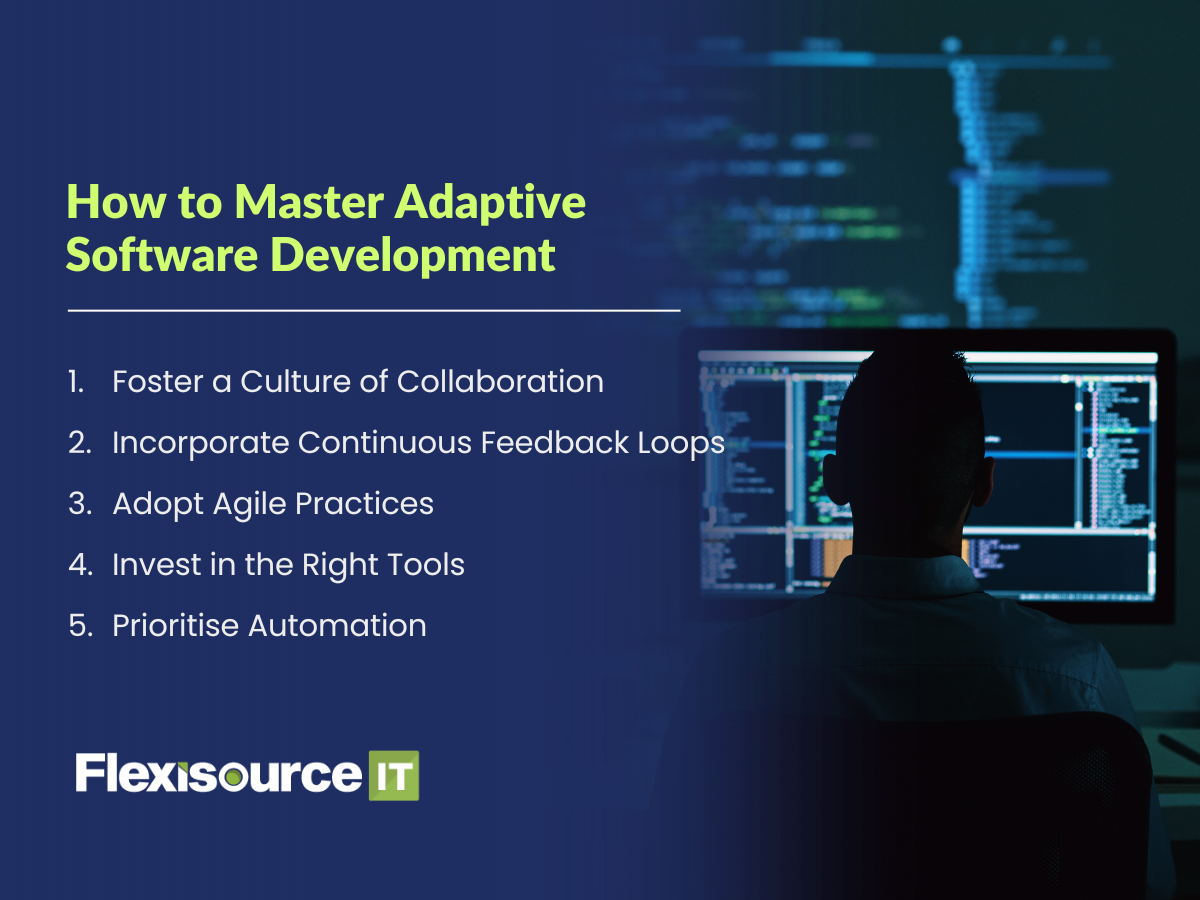In today’s fast-paced digital world, businesses are continuously seeking innovative ways to stay competitive and meet evolving customer demands. One of the most transformative methodologies in software development is Adaptive Software Development. As technology evolves and markets shift, organisations must be ready to adapt quickly, making ASD an essential strategy for modern development teams.
This article explores what Adaptive Software Development is, why it is crucial for 2025, and how businesses can master it to ensure long-term success.
What is Adaptive Software Development?
Adaptive Software Development (ASD) is an agile-based approach that emphasises flexibility, collaboration, and iterative progress. Unlike traditional software development methodologies that rely on a linear and rigid process, ASD focuses on building software in small, manageable increments, allowing teams to respond to change with ease.
At its core, ASD is about anticipating and embracing change rather than avoiding it. By continuously testing, refining, and improving the software in short cycles, teams are empowered to address customer needs and market changes as they occur. This adaptive approach provides the agility needed to produce high-quality software that aligns with real-world requirements.
Why Adaptive Software Development is Essential
The technology landscape is evolving faster than ever before, and businesses need to stay ahead of the curve to maintain their competitive edge.

1. Rapid Technological Advancements
With the rapid pace of innovation, technologies like artificial intelligence (AI), machine learning (ML), and the Internet of Things (IoT) are reshaping industries. Businesses need a development process that allows them to integrate these technologies effectively and adapt to new challenges. ASD provides the necessary flexibility to leverage emerging tools and methodologies without disrupting ongoing projects.
2. Customer-Centric Development
Customer expectations continue to evolve. Gone are the days when businesses could deliver software without constant feedback loops. Adaptive Software Development places customer feedback at the heart of the development process, allowing teams to continuously improve their products to meet the dynamic needs of the user base.
3. Increased Focus on Continuous Delivery
Continuous delivery and integration are increasingly becoming the norm for software projects. ASD ensures that teams can release updates frequently, adapting to new information, changes in customer needs, and shifting market demands without delays.
4. Managing Uncertainty & Complexity
The complexity of software projects is only increasing. ASD is perfect for handling this complexity by promoting collaboration among cross-functional teams, breaking down large tasks into smaller, more manageable ones, and responding quickly to emerging issues. This makes it ideal for fast-moving industries where change is constant and unpredictability is common.
5. Competitive Advantage
As the software industry grows more competitive, having an adaptive methodology in place can differentiate your business. ASD allows teams to respond faster than competitors, adapting to market changes and emerging trends, thus positioning your brand ahead of others in the race for innovation.
Key Principles of Adaptive Software Development
Mastering Adaptive Software Development requires understanding the key principles that drive this methodology.

1. Iteration Over Perfection
ASD encourages teams to embrace iteration. Instead of spending months trying to build the “perfect” product, teams focus on delivering working increments of software regularly. This allows for constant refinement, user testing, and feedback integration to ensure that the final product meets the evolving needs of customers.
2. Collaboration & Communication
The success of ASD relies heavily on effective communication between stakeholders, developers, and customers. Collaboration is key in identifying problems early, solving them quickly, and making necessary adjustments to the development process. Teams that communicate openly and often can deliver higher-quality solutions faster.
3. Embracing Change
One of the foundational tenets of ASD is that change is inevitable and should be welcomed. This mindset fosters a culture of flexibility, where the focus is on delivering value rather than strictly adhering to a fixed set of requirements. This adaptability ensures that the development process remains responsive to shifts in technology and customer preferences.
4. Focus on Delivering Value
ASD isn’t just about shipping code; it’s about ensuring that each iteration delivers tangible value to the end user. Teams prioritise features that will have the most significant impact on the user experience, continuously improving the software based on user input and testing.
5. Transparency in Progress
ASD requires clear visibility into the development process. This transparency ensures all stakeholders—whether internal teams or clients—are kept in the loop. By providing updates on progress and challenges, teams can address concerns before they escalate and ensure that projects stay on track.
How to Master Adaptive Software Development
To truly master Adaptive Software Development, organisations must embrace several key strategies and best practices.

1. Foster a Culture of Collaboration
Successful ASD relies on collaboration. Encourage regular meetings, brainstorming sessions, and collaborative decision-making across all teams involved. By promoting open dialogue and shared ownership of the project, you create a working environment where feedback is valued, and improvements happen more rapidly.
2. Incorporate Continuous Feedback Loops
Implement regular feedback loops with both internal stakeholders and end users. Use this feedback to refine product features and functionality, ensuring that the development process remains aligned with market needs. This iterative process helps mitigate the risks of misaligned priorities or unmet user needs.
3. Adopt Agile Practices
While ASD is a methodology in itself, it aligns closely with agile practices such as Scrum or Kanban. These practices emphasise working in short sprints, delivering incremental value, and making adjustments based on real-time feedback. Adopting these methodologies will ensure your teams remain flexible and can adapt to changing requirements swiftly.
4. Invest in the Right Tools
To master ASD, teams need the right set of tools for continuous integration, delivery, and collaboration. Tools like Jira for project tracking, Git for version control, and Slack for communication can streamline workflows and enhance the effectiveness of your development processes.
5. Prioritise Automation
Automation is key to achieving the speed and agility needed in ASD. Automate repetitive tasks such as testing, deployment, and monitoring to free up your development teams for more value-driven tasks. This will increase efficiency and ensure high-quality software delivery.
Conclusion
Mastering Adaptive Software Development is more than just a trend—it’s a critical component of success for businesses in 2025 and beyond. By adopting ASD principles such as iteration, collaboration, and embracing change, organisations can develop high-quality software that meets the dynamic needs of customers while remaining competitive in an ever-evolving digital landscape.
With the right tools, strategies, and mindset, businesses can harness the power of Adaptive Software Development to deliver exceptional, customer-centric solutions that stand the test of time. The future of software development is adaptable, and mastering this approach will position your team for success in the years to come.
Ready to future-proof your software development process? Contact Flexisource IT today to get started!







